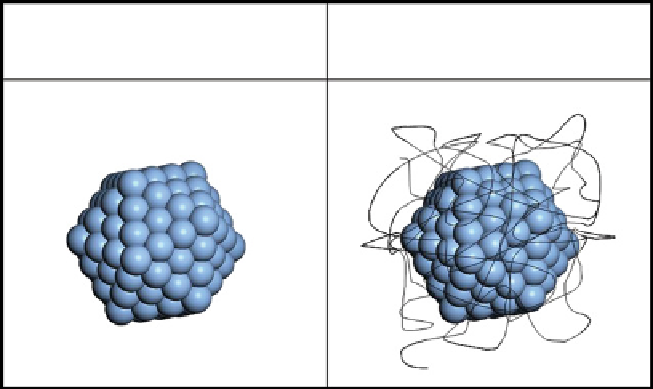Environmental Engineering Reference
In-Depth Information
Metallic nanoparticle with a
stabilizing polymer surface or
core
Metallic nanoparticle
fIgure 22.3
schematic of a metallic nanoparticle in the left column of the table. In the right column of the table, a schematic of a metallic
nanoparticle with a shell or film covering its surface is shown.
Electron cloud
-
-
-
Electromagnetic
field
+
+
+
Metallic nanoparticles
Energy dissipated
thermally
fIgure 22.4
Illustration of the mechanism of heat dissipation by the surface electrons present in metallic nanoparticles when they are
exposed to a specific wavelength and excited by an electric field.
plasmon-resonance wavelength, and follow a photothermal phenomenon where, due to energy relaxation of the surface elec-
trons to the phonon bath, the resonant energy is dissipated as heat to the local surroundings (Fig. 22.4). This raises the temper-
ature of the particles' surroundings when illuminated by a light source, such as a laser. smaller particles and structures such
as nanorods, nanorings, and nanoshells convert most of the absorbed energy into heat since they present larger surface-to-
volume ratios and less scattering, which therefore enhance the optothermal conversion efficiency, thus producing larger incre-
ments of temperature in the surrounding environment [43, 68].
Temperature increments of gold and silver nanoparticles have been measured using polarization interference, which allows
detection of slight phase changes induced by heating. efficient energy conversion increases the local temperature in the
immediate vicinity of the particle up to 15 K [72], and work on different structures such as nanocrescent has achieved incre-
ments of up to 60 K in the nanostructure vicinity [43].
22.6 synthesIs routes of envIronmentally sensItIve polymer-metal
nanopartIcle hybrIDs
one popular synthesis method to produce metallic nanostructures is wet chemistry reactions since they are relatively cheap and
capable of producing colloidal suspensions of homogeneous particles in large quantities. The ingredients in the liquid phase are
the metal salt precursor, which is reduced to its metallic form by a reducing agent such as ethylene glycol [63, 73, 74], sodium


